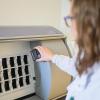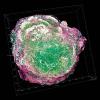Peter Smith, Principal Clinical Scientist in Cellular Pathology at Liverpool Clinical Laboratories, gives a personal account of his experiences of the Scientist Training Programme.

The NHS Scientist Training Programme (STP) is comfortably over 10 years old now and is well established as the route to train clinical scientists in genetics, physical sciences, biochemistry, microbiology and many more disciplines. At its best, it gives graduates an accelerated route to advanced practice, with placements in related disciplines and genetics a pillar of any programme in life sciences.
Yet in histology, a discipline with a substantial and ever-expanding demand for advanced practitioners, placements are few and far between. I believe that this is primed to change and that the STP will become a more established route to histopathology reporting over the years to come.
My background
I undertook the histology STP in 2012 immediately after graduating from university, where I’d studied biomedical sciences and taken a year out to complete my IBMS Certificate of Competence.
I think the fact that I interviewed for the STP programme within months of graduating and becoming a registered biomedical scientist was key to being offered the post – it operates as an integrated Master’s degree programme, combining academic study with workplace learning and training.
NHS laboratory experience made a real difference and was, I believe, the reason why many other candidates didn’t make it past the interview process.
Experience of the STP
The STP was a fantastic opportunity and one I feel very lucky to have received. I’ve no doubt in my mind that it accelerated my professional development and has played a huge part in enabling me to complete the Advanced Specialist Diploma (ASD) in Histopathology Reporting at the (relatively) young age of 34. You do have to work for it, though.
The trickiest part of the STP, particularly when appointed to a newly created, or “direct-entry” post, is to simultaneously complete a Master’s degree, learn four disciplines to a specialist biomedical scientist level, develop the required skills in dissection and microscopy, and to remain useful enough to justify the department keeping you around.
The benefit of it was that I was able to begin dissecting specimens within two years of graduating, participate in microscopy and progress straight to a senior role in the laboratory upon completion of the programme.
Histopathology reporting
The IBMS/RCPath ASD in Histopathology Reporting trains biomedical and clinical scientists to perform histopathology reporting to a consultant level, and is currently available for the dermatopathology, gastrointestinal pathology and gynaecological pathology subspecialties. To be eligible, candidates typically need to be a Member or Fellow of the IBMS, have been practising for at least five years and, preferably, to have attained the Diploma of Expert Practice in Histology Dissection. The eligibility criteria also allow for those who’ve completed the STP to progress to the ASD following a couple of years of experience, and this is the route I took.
I was able to apply for and be appointed to a post that had been created following a successful business case, one for which the ASD was an integral component, and one which came without managerial responsibility, consisting of an even split between specimen dissection and reporting. This was only made possible by the experience of colleagues who’d attempted the qualification before me and found their reporting time to be progressively constricted by the other duties of their job.
“It gives graduates an accelerated route to advanced practice, with placements in related disciplines and genetics as a pillar”
Like the STP, the ASD in Histopathology Reporting has been running for more than a decade now, and like the STP it has suffered from slow uptake. Manifold factors contribute to this, but the most common are a lack of time for pathologists to teach candidates and/or a lack of dedicated time in the candidate’s job for reporting. Indeed, the relative rarity of medic-style job plans among scientists is itself a contributor to the difficulties ASD candidates face.
Nevertheless, due to declining availability of consultant histopathologists creating service need, greater numbers of scientists are now undertaking the ASD (I sat the Stage C exam last year with 11 other candidates).
I believe that the STP prepared me well for the ASD. I had prior experience of benign gynae dissection and of malignant dissection in other subspecialties, which allowed me to get up to speed dissecting malignant gynae specimens independently within two months of starting the role. The prior experience I’d gained of microscopy during the STP course also helped, albeit in a more limited way, since this time I was learning with the ultimate aim of independent reporting, rather than learning from a purely educational standpoint.
Conclusion
Overall, the STP represents an alternative route to advanced practice for those undertaking it, and can be used by trusts to develop members of staff to a point where they’re able to commence the ASD in Histopathology Reporting. With the forthcoming shortfall in the number of histopathologists, there’s plenty of reason for this to become another route to advanced practice in histology.
Image credit | Shutterstock




